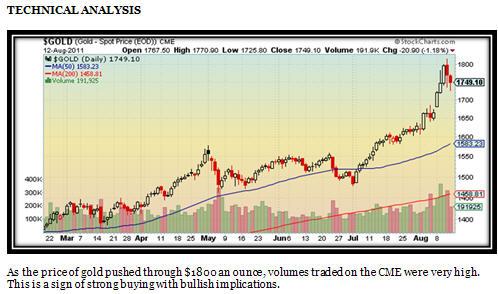These times of tumultuous change will push the price of gold much higher
Global markets were on a roller coaster last week ever since Washington agreed to increase their debt ceiling and S&P downgraded the USA’s AAA credit rating to AA+. Interestingly, the Chinese credit agency Dagong, had already downgraded the US credit rating last year, but no one really paid any attention to their opinion.
As global equities tumbled and then rebounded, the EUR/USD pair fluctuated widely. Having traded currencies for many years, I can state that I have not seen such wild swings so frequently in a very long time. Usually, the US non-farm payrolls were the most watched indicator having the ability to move the pair by more than 120 pips on average. The unemployment rate is a measure of the strength of the US labour market, and one of the ways analysts gauge the strength of an economy is by the number of jobs created and the percentage of workers unable to find jobs. Strong job creation is indicative of economic growth as companies must increase their workforce in order to meet demand. The next most widely watched indicator used to be the FOMC interest rate decisions. The average move of the EUR/USD pair following an interest rate decision could be around 75 pips. This was then followed by a series of other indicators including the US trade balance, CPI and retail sales. But, during the last few weeks we have seen swings in the EUR/USD pair of close to 200 pips on talks of bank defaults, country defaults, bank and country bailouts etc. One day the greenback would gain against the euro, the next day it would pare its gains of the previous day. It seemed as if traders who went long one day, went short the next day. And, as this happened, the price of gold continued to soar. The message was very clear – people are losing confidence in the current global monetary system caused by a myriad of problems including the massive sovereign debt world-wide, huge government deficits and lack of economic growth in the two economic power regions namely the USA and the Eurozone.
Interestingly enough, while global equities and most commodities tumbled, the price of gold made new highs almost on a daily basis. And, then as it broke through the $1800 an ounce level, the CME Group raised margins for trading Comex 100 ounce contracts by 22.2% on Wednesday. But, no matter what the CME have done or plan to do, they will not resolve the issues facing our fiat currency system and thus will not be able to stem the flow of funds into gold as it has proven too much an attraction as an alternative investment and the margins may not have as much influence.
Historically, when margins are raised significantly it tends to cause a bit of sell-off as we all witnessed when the CME raised the margin requirements 6 times in a week in the silver market when it recently ran up to $50 an ounce. And as soon as the price of gold drops, most analysts instruct their investors not to touch it as it is too high. They claim that they only buy when prices are low. Yet, even when prices were low, they were not buying. A typical example of this is when one of the more prominent financial experts and well-known economist, Nouriel Roubini, professor of economics at the New York University’s Stern School of Business said gold was a bubble when the price was $1100 an ounce.
On Decemember 10, 2009 with gold at $1100 an ounce, Roubini said, “all the gold bugs who say gold is going to $1500, $2000, they’re speaking nonsense. Roubini went on to say, “I don’t believe in gold.”
Gold has now risen more than 60% since then. I wonder what Roubini has to say now. But believe me he is not alone in this type of thinking. In South Africa every single main stream commentator got it wrong. Yet, they have not changed their myopic views about gold and still refuse to recommend it to investors as a portfolio diversifier.
As I mentioned countless times, we live in times of tumultuous change. We do not know what is going to happen the next day. Paper assets can soar or sink as we have recently witnessed last week. Some shares dropped suddenly by more than 20%! That is like saying the price of gold has dropped overnight by $350 an ounce. Yet, as soon as the price of gold does drop, even if it is $50 an ounce, most analysts slam gold as a bad investment. This only goes to show that they have no knowledge of the global monetary system and why the price of gold continues to move higher. Through centuries of war and peace, feast and famine, gold has always been a consistent store of value and a trusted medium of exchange. Gold has an intrinsic value and has been used as money and as a store of value for more than 5000 years.
Just as I expected, the rating agency S&P have come under a lot of criticism for their downgrade of US credit. Yet, when, the Chinese rating agency Dagong Global Rating Co downgraded the US last year, they were practically laughed at. Last Wednesday the agency once again cut the credit rating of the US from A+ to A with a negative outlook.
What people seem to forget is that China is by far the largest foreign holder of the US debt with holdings amounting to $1.15 trillion as of the end of April and so while US policy makers play their political games, their decisions will impact on the value owing to their largest foreign creditor.
The agency said the approval to raise the debt ceiling indicated that there will not be any positive changes in factors that will influence the country’s debt-paying ability in the long run.
The growth of the US new debts has so far outpaced the rate at which it reduces its fiscal deficit, as there are not reliable or feasible policies put in place to support the country’s plan to cut federal spending, it said.
Dagong estimated that the United States has to reduce no less than $4 trillion in its fiscal deficit in the coming five years to sustain its liability scale.
As the US battles with their own problems Europe’s problem seem a lot worse. And, while the ECB continue to buy government bonds, they cannot do this indefinitely without debasing the euro substantially. So, the race to the bottom continues. As for who will get their first, right now I see Europe with a slight lead.
As portfolio managers have traditionally invested in bonds as a means of diversifying their equity portfolios, they have completely ignored alternative asset classes in particular precious metals. And, while they still lambast gold as an investment because it does not pay a dividend, they also fail to concede that gold has been a much better investment than equities for several years now. But that is not the reason to invest in gold. While it is unlikely that new investors into gold are going to make those huge speculative returns seen over the last 10 or even 5 years, the best thing you can still do is own some gold. It provides you with a store of value; it will protect your wealth, and politicians cannot devalue or confiscate it from you, especially if you do not have it stored at a bank.
Information contained herein has been obtained from sources believed to be reliable, but there is no guarantee as to completeness or accuracy. Any opinions expressed herein are statements of our judgment as of this date and are subject to change without notice.
More News
{{ commodity.name }}
{{ post.title }}
{{ post.date }}


Comments